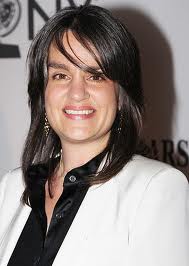
Andrew Keenan-Bolger and Carolyn McCormick in A.R. Gurney’s Family Furniture at the Flea Theater. (Photo by Joan Marcus)
Playwright AR Gurney would have found great irony in the fact that his life was commemorated at Broadway’s Music Box Theatre this week because, despite his success, Broadway was never much of a home to him.
Only four of his nearly 40 plays ever made it to the Great White Way, and the longest run was for his 1987 work Sweet Sue, which eked out six months including previews. Gurney attributed that entirely to the presence of Mary Tyler Moore and Lynn Redgrave in the four-strong cast.
The playwright, known to one and all as Pete for reason long lost to his family lore, had a career that flourished Off-Broadway and in regional theatres. When he died in June at the age of 86, there were the appropriate obituaries for such a successful and prolific man of the theatre. But there were few critical surveys of his career, or think pieces about what his plays had meant, like those that followed the deaths of Edward Albee and Sam Shepard.
Gurney’s work was never groundbreaking, but it resonated strongly with audiences of many ages, even though it was steeped in the lore of the white Anglo-Saxon Protestants who had dominated America for many years.
From the very start, Gurney was quietly, subtly rebelling against his genteel upbringing, simultaneously taking pleasure in the traditions that had surrounded him growing up while poking fun at them theatrically.
At Tuesday’s memorial, it was noted that his father took genuine displeasure at Gurney’s chosen career and the sentiments expressed in his plays. Despite that, until his father’s death, he was always billed as A.R. Gurney Jr., out of respect.
As it happens, I first had the opportunity to meet and work with Pete in 1984, when I was only two weeks out of college. He had only truly broken through in his career two years earlier, at the age of 52, with his comedy The Dining Room.
While he was fond of noting the critical reception for Scenes from American Life in 1971, it was The Dining Room that made his name, and allowed him to stop teaching full-time – that alternate profession had sustained him for two decades. He didn’t fit the model of an emerging playwright in appearance, demeanour or choice of dramatic subjects.
I didn’t quite realise this at the time, and I treated him as I treated every artist I met in my earliest years: with something approaching awe. But Pete’s warmth and genuine interest in every person he met led to a professional friendship that lasted the rest of his life, even though he was only three years younger than my dad. When I took a new job in 2003, he called me to say he was proud of me – the most paternal gesture I can imagine, and one that I will never forget.
Being a younger, Jewish man, Pete’s works held a certain anthropological fascination for me. As I watched his plays over the years, often with audiences that seemed to have stepped out of his plays – as did much of the crowd at his memorial – it struck me that they were coming to see their way of life satirised, criticised and – perhaps against their will – eulogised.
Pete’s particular gift, lost to the casual observer, was that he managed to do this without giving offence. I liked to say that his audiences recognised his characters as the family down the street, but never as themselves.
At the memorial, actor Holland Taylor, who had worked with Pete often, said: “He may have hung his heritage out to dry, but he was always dressed in it the next day.”
Pete’s greatest success was certainly his play Love Letters, which was translated into 24 languages and produced in 40 countries. In its simplicity, it was perhaps his most structurally daring play: two actors, seated at a table, reading from their scripts, never looking at one another until the penultimate moment, requiring no rehearsal, consisting entirely of a life-long correspondence of unrequited love.
What few recall is that Love Letters followed his uncharacteristic work The Snow Ball. While his plays typically called for a single set and perhaps six actors at most, The Snow Ball took place in multiple locations, called for a cast of about 16, and if memory serves, about 80 costumes.
Yes, I worked on his most technically complex play, and one of his least seen. At the memorial, director Jack O’Brien railed against a now-deceased Boston critic who had derailed its path to New York.
I will miss Pete always, and with that I will miss the Off-Broadway era that allowed him such great success. While his regional productions were legion, and presumably will remain so, we no longer see the days when plays would transfer from Playwrights Horizons, the late Circle Repertory or other not-for-profit venues to sustained commercial runs Off-Broadway, as Pete’s did.
Now plays either move on to Broadway or they finish their limited runs and are lost to New York, more often than not setting the stage for larger audiences and bigger royalties outside of the city than in it.
Pete didn’t mourn the passing of the world in which he was raised; he told me it was culturally bankrupt when I interviewed him in 2015. But with his death I mourn the passing of an era when plays didn’t have to move to Broadway in order to have a chance of survival in New York, and could find ongoing homes in smaller theatres.
Without that, I fear we lose the opportunity to foster emerging playwrights most fully, whether they’re 20-year-old tyros or, like Pete, 50-year-old overnight successes.







